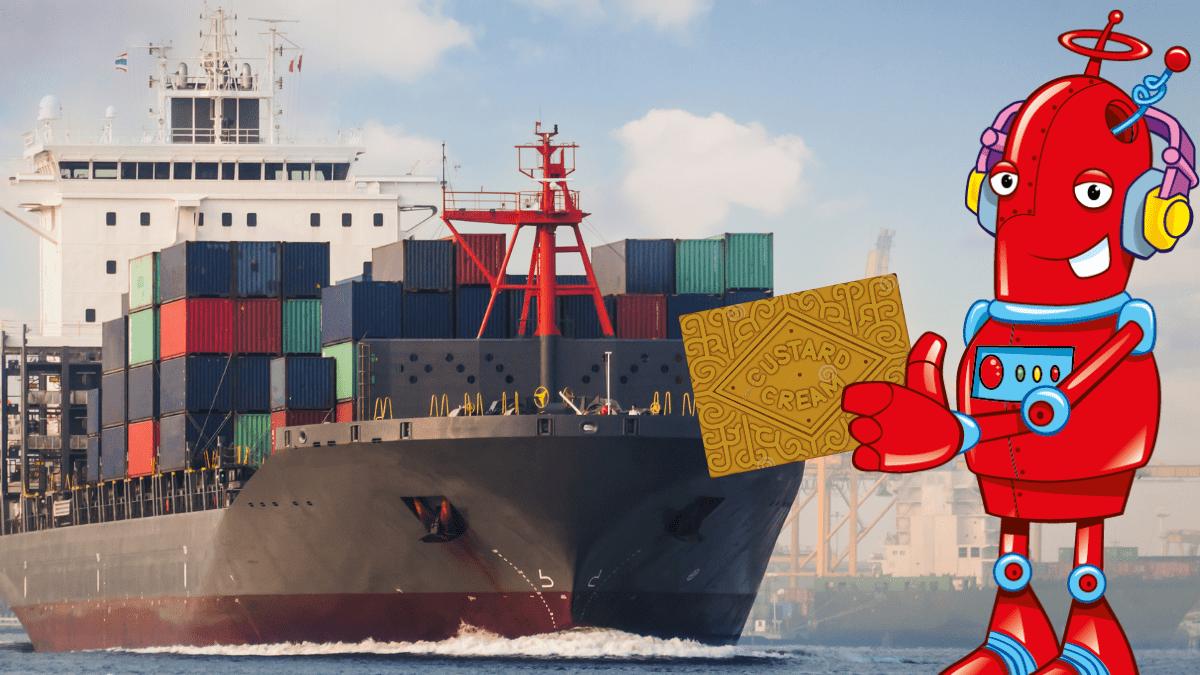In Sean’s Ships: Bringing the World Together, Sean and Robot are on a mission to sell custard creams across the world and with the help of the Captain, have been learning all about ships and world trade.
In this series of Sean’s Ships we’ve been learning all about international trade – that’s the way different countries exchange stuff. A bit like the way you might trade things with friends in Minecraft.
One of the things we haven’t really explored yet, is the design and workings of a cargo ship.
Plus once you’re an expert on Cargo Ships don’t forget to try the quiz!
Cargo Ships of the Past
Ships have been used for thousands of years. The oldest ever found is the Pesse Canoe which is believed to be 10,000 years old.
One of the earliest types of ship is one you might have made yourself. A raft!

The first ships would have been basic rafts and canoes. That was until a very important invention… the sail, which lets wind power do all the work, rather than human muscle alone. Ships could travel further and for longer – allowing people to explore greater distances than ever before. Over time, ships got more and more specialised, with different types for fishing, transporting products and also carrying people.
Egyptian Cargo Ships
Some of the first cargo ships were made by the Egyptians.
The Egyptians built their cargo ships by lashing and sewing together small pieces of wood. The ships were so strong they could carry huge stones weighing over 300 tonnes. The stones needed to be huge to make big statues. The Egyptians travelled across the Mediterranean and Red Sea to trade with other ancient civilisations.
Viking Cargo Ships

The Vikings were famous for invading many places by ship. Most of their ships were long and narrow, with an animal like a dragon at the front.
The Viking cargo ship is known as Knarr. Its hull is wider, deeper and shorter than a Viking longship. This allowed Vikings to take more cargo. They’d be loaded with wool, wheat, honey and armour and then sail across the Baltic Sea, they could even carry sheep to settlements in Iceland.
Modern Cargo Ships
Just like those Egyptian and Viking cargo ships were designed to carry cargo, modern cargo ships are the same – with different shapes and sizes depending on the job. There’s certainly plenty of work to be done with around 1.8 billion metric tons of cargo shipped annually.
A typical cargo ship can be over 360 metres long – that’s longer than 30 buses!
Some cargo ships are special ships designed to carry cars and trucks. They have a garage into which the cars are driven so they don’t have to be hoisted on like shipping containers.
Other cargo ships such as oil tankers are also designed specially. On an oil tanker the bottom of the ship is divided into different tanks. By splitting the hull into tanks, oil can be loaded and unloaded with multiple pumps making a faster process. It also means that if something happens to the ship, and the oil spills out, they can limit how much oil is lost. Oil spills are really damaging to nature and sea life so minimising how much destruction could be caused is really useful.

Then you’ve got your container ships for carrying, well virtually anything that can fit inside a container. They’re pretty much the shipping workhorse these days. With something like 55,000 container ships around the world, there’s a ship to carry whatever you need, wherever you want it to go.
Now you’re a Cargo Ships expert why not try our quiz?
Sean’s Ships – Bringing the World Together. With support from Lloyd’s Register Foundation.
Add a commentSean’s Ships
How do ships work and why are there so many routes? Sean's exploring the history and science behind ships and international trade!
More From Sean’s Ships






